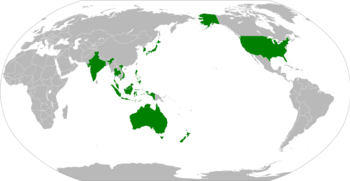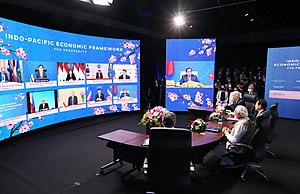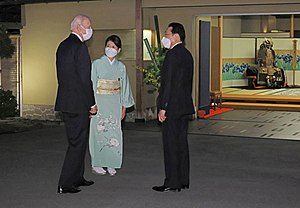Indo-Pacific Economic Framework
Indo-Pacific Economic Framework for Prosperity | |
|---|---|
 Members of IPEF | |
| Type | Economic initiative |
| Membership | 14 countries |
| Establishment | 23 May 2022 |
Indo-Pacific Economic Framework for Prosperity (IPEF) is an economic initiative launched by United States President Joe Biden on May 23, 2022.[1][2] The framework launched with a total of fourteen participating founding member nations, with the late entry of Fiji, the first South Pacific Island to join, with an open invitation for other countries to join at any time.
Biden described the initiative as "writing the new rules for the 21st century economy", stating that the agreement would make the participant's economies "grow faster and fairer". Commerce Secretary Gina Raimondo argued that the framework constituted "the most significant international economic engagement that the United States has ever had in this region".[3] Analysts have compared it to the Trans-Pacific Partnership which the United States withdrew from in 2017.[4]
The initiative is intended to be a precursor for later negotiations, as it does not include a uniform lowering of tariffs.[5]
The four themes of the proposed IPEF are:[6]
- Fair and resilient trade
- Supply chain resilience
- Infrastructure, clean energy, and decarbonization
- Tax and anti-corruption
Participating nations
IPEF has fourteen member states and represents 40% of world GDP.[2]
 Australia
Australia Brunei
Brunei Fiji[7]
Fiji[7] India (partly opted out on the trade pillar[8])
India (partly opted out on the trade pillar[8]) Indonesia
Indonesia Japan
Japan South Korea
South Korea Malaysia
Malaysia New Zealand
New Zealand Philippines
Philippines Singapore
Singapore Thailand
Thailand United States
United States Vietnam
Vietnam
Reactions
Chinese Foreign Minister Wang Yi criticized the initiative as an attempt to further economic decoupling from China. Wang Yi argued that the initiative, and the US Indo-Pacific strategy as a whole, created divisions and "incited confrontation". Wang stated that such an agreement would "ultimately be a failure".[9]
Many analysts have criticized the lack of inclusion of Taiwan in the framework, with Taiwan News calling the lack of inclusion a "snub".[10] An opinion piece published in The Hill asserted that Taiwan was excluded in order to appease key "fence-sitter" countries such as Indonesia whose governments feared angering China.[11]
Former Malaysian Prime Minister Mahathir Mohamad criticized the grouping as an initiative intended to isolate China, saying "many countries recognize that this is not an economic grouping but it is truly a political grouping."[12]
Indian Position
The Indo-Pacific Economic Framework is relied on four pillars namely tax, anti-corruption, clean energy and data and privacy. So far, India has agreed to three pillars relating to supply chains: tax, anti-corruption and clean energy, but the fourth pillar on data and privacy is yet to be completely agreed upon. Prabir De of the Research and Information System for Developing Countries, a think tank of the MEA, wrote that India may be uncomfortable with the US high standards, and would like to avoid risks. He further added, “Some areas proposed in the IPEF do not appear to serve India’s interests. For example, the IPEF talks about digital governance but the IPEF formulation contains issues that directly conflict with India’s stated position.”, Minister of Commerce & Industry Piyush Goyal also said at the press conference that India was in the process of firming up its own digital framework and laws, particularly regarding privacy and data, and it would wait for more information. In the meantime, officials will be participating in the discussions “with an open mind”.[13]
Comparison with RCEP
The Indo-Pacific Economic Framework would "outweigh" in both population and gross domestic product the Regional Comprehensive Economic Partnership.[14] The only RCEP members not also included in the IPEF are China, Myanmar, Cambodia, and Laos; while non-RCEP members are the United States, India, and Fiji.
References
- ^ Liptak, Kevin (2022-05-23). "Biden unveils his economic plan for countering China in Asia | CNN Politics". CNN. Archived from the original on 2022-05-31. Retrieved 2022-05-24.
- ^ a b "FACT SHEET: In Asia, President Biden and a Dozen Indo-Pacific Partners Launch the Indo-Pacific Economic Framework for Prosperity". whitehouse.gov. 2022-05-23. Archived from the original on 2022-05-31. Retrieved 2022-05-24.
- ^ Baker, Peter; Kanno-Youngs, Zolan (23 May 2022), "Biden to Begin New Asia-Pacific Economic Bloc With a Dozen Allies", New York Times (published May 23, 2022), archived from the original on May 24, 2022, retrieved May 24, 2022
- ^ In Tokyo, Biden set to launch new Indo-Pacific trade pact to replace TPP, Marketwatch, archived from the original on 2022-05-24, retrieved 2022-05-24
- ^ "Joe Biden waters down Indo-Pacific Economic Framework to win more support", Financial Times, 20 May 2022, archived from the original on 2022-05-24, retrieved 2022-05-24
- ^ "Statement on Indo-Pacific Economic Framework for Prosperity". The White House. 2022-05-23. Archived from the original on 2022-05-28. Retrieved 2022-05-28.
- ^ Manager, Ritika Pratap Deputy News. "Fiji joins Indo-Pacific Economic Framework for Prosperity". Fiji Broadcasting Corporation. Archived from the original on 2022-05-27. Retrieved 2022-05-27.
- ^ "India stays out of Indo-Pacific trade pillar". The Times of India. 2022-09-10. Retrieved 2022-10-06.
- ^ China says Washington's 'divisive' Indo-Pacific strategy doomed to fail, South China Morning Post, 23 May 2022, archived from the original on 2022-05-24, retrieved 2022-05-24
- ^ US snubs Taiwan from Indo-Pacific Economic Framework, Taiwan News, 23 May 2022, archived from the original on 2022-05-24, retrieved 2022-05-24
- ^ Tong, Kurt (11 May 2022). "Congress should get creative on Taiwan". The Hill. Archived from the original on 25 May 2022. Retrieved 25 May 2022.
- ^ Yamaguchi, Mari (27 May 2022). "Ex-Malaysia PM: US-led trade group intended to isolate China". Associated Press. Archived from the original on 28 May 2022. Retrieved 28 May 2022.
- ^ "India accepts three out of four pillars of US-led IPEF, so why has it stopped short of a total agreement?". 10 September 2022.
- ^ U.S.-led IPEF outweighs China-involving RCEP in population, GDP, Yonhap News Agency, 23 May 2022, archived from the original on 2022-05-24, retrieved 2022-05-24

